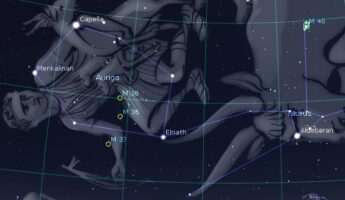This Week’s Sky at a Glance, 2023 Oct. 28 – Nov. 4
This Week’s Sky at a Glance, 2023 Oct. 28 – Nov. 4
Open clusters, sometimes called galactic clusters, are groups of relatively young stars (usually less than 500 million years old) that formed from the same vast cloud of gas and dust. The Pleiades cluster (M45) in the shoulder of Taurus the Bull is seen easily with the naked eye because it is fairly close at 440 light years (mind you, a light year is 9.5 trillion kilometres). The V-shaped Hyades in the face of Taurus is the closest at 150 light years, although Aldebaran at one end of the V is actually a foreground star at a distance of 65 light years. Many other clusters are greater than ten times farther and require binoculars or a telescope to be seen at all, usually as a hazy patch with some individual stars.
To the left of Taurus is a pentagram of stars marking the head, shoulders and knees of the constellation Auriga the Charioteer. One of those stars – in Auriga’s right knee, with him facing us – is officially part of Taurus. Point your binoculars halfway between this star and the one in Auriga’s right shoulder. Open cluster M36 is just inside the line between the stars, and M37 is just outside. They look like fuzzy patches because, at distances of greater than 4000 light years, a telescope is required to resolve individual stars. Further inside is the diffuse open cluster M38, midway between the right shoulder and left knee. All three clusters can be seen together in wide-field binoculars.
This Week in the Solar System
Saturday’s sunrise in Moncton is at 7:53 and sunset will occur at 6:11, giving 10 hours, 18 minutes of daylight (7:57 and 6:17 in Saint John). Next Saturday the Sun will rise at 8:03 and set at 6:00, giving 9 hours, 57 minutes of daylight (8:07 and 6:07 in Saint John).
The full Hunter’s Moon rises at sunset this Saturday and nears Jupiter overnight, resulting in a scenic couple on Sunday morning. On early Sunday evening a telescope or binoculars might show Uranus to the lower right of the Moon. Jupiter is the focus of the week, reaching opposition on Friday. On Monday telescope users can watch its moon Ganymede disappear into the planet’s shadow at 8:50 pm and reappear at 10:36. Saturn is at its best for observing in the early evening, while Venus rivals the Moon and Jupiter in the morning sky. Mars and Mercury are too close to the Sun for observing.
The Sunday Night Astronomy Show from Saint John and Hampton airs at 8 pm Sunday on the Facebook page and YouTube channel of Astronomy by the Bay.

